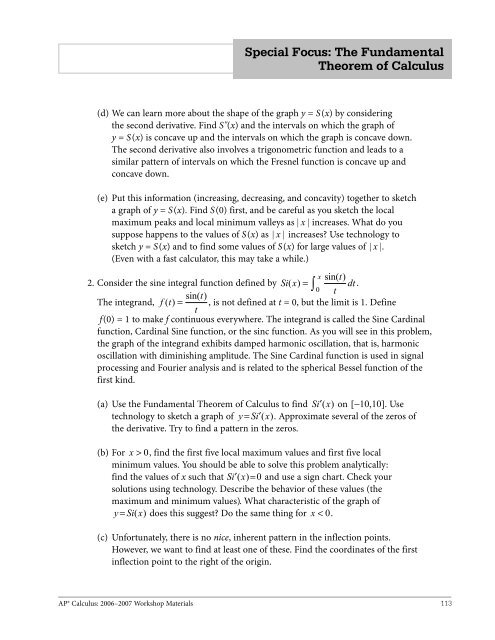AP Calculus
Create successful ePaper yourself
Turn your PDF publications into a flip-book with our unique Google optimized e-Paper software.
Special Focus: The Fundamental<br />
Theorem of <strong>Calculus</strong><br />
(d) We can learn more about the shape of the graph y = S(x) by considering<br />
the second derivative. Find S"(x) and the intervals on which the graph of<br />
y = S(x) is concave up and the intervals on which the graph is concave down.<br />
The second derivative also involves a trigonometric function and leads to a<br />
similar pattern of intervals on which the Fresnel function is concave up and<br />
concave down.<br />
(e) Put this information (increasing, decreasing, and concavity) together to sketch<br />
a graph of y = S(x). Find S(0) first, and be careful as you sketch the local<br />
maximum peaks and local minimum valleys as | x | increases. What do you<br />
suppose happens to the values of S(x) as | x | increases? Use technology to<br />
sketch y = S(x) and to find some values of S(x) for large values of | x | .<br />
(Even with a fast calculator, this may take a while.)<br />
x sin( t)<br />
2. Consider the sine integral function defined by Si( x)<br />
= ∫ dt .<br />
0 t<br />
sin( t)<br />
The integrand, f ( t)<br />
= , is not defined at t = 0, but the limit is 1. Define<br />
t<br />
f(0) = 1 to make f continuous everywhere. The integrand is called the Sine Cardinal<br />
function, Cardinal Sine function, or the sinc function. As you will see in this problem,<br />
the graph of the integrand exhibits damped harmonic oscillation, that is, harmonic<br />
oscillation with diminishing amplitude. The Sine Cardinal function is used in signal<br />
processing and Fourier analysis and is related to the spherical Bessel function of the<br />
first kind.<br />
(a) Use the Fundamental Theorem of <strong>Calculus</strong> to find Si′( x) on [ −10, 10 ]. Use<br />
technology to sketch a graph of y = Si′( x). Approximate several of the zeros of<br />
the derivative. Try to find a pattern in the zeros.<br />
(b) For x > 0, find the first five local maximum values and first five local<br />
minimum values. You should be able to solve this problem analytically:<br />
find the values of x such that Si′ ( x) = 0 and use a sign chart. Check your<br />
solutions using technology. Describe the behavior of these values (the<br />
maximum and minimum values). What characteristic of the graph of<br />
y = Si( x) does this suggest? Do the same thing for x < 0.<br />
(c) Unfortunately, there is no nice, inherent pattern in the inflection points.<br />
However, we want to find at least one of these. Find the coordinates of the first<br />
inflection point to the right of the origin.<br />
<strong>AP</strong>® <strong>Calculus</strong>: 2006–2007 Workshop Materials 113


